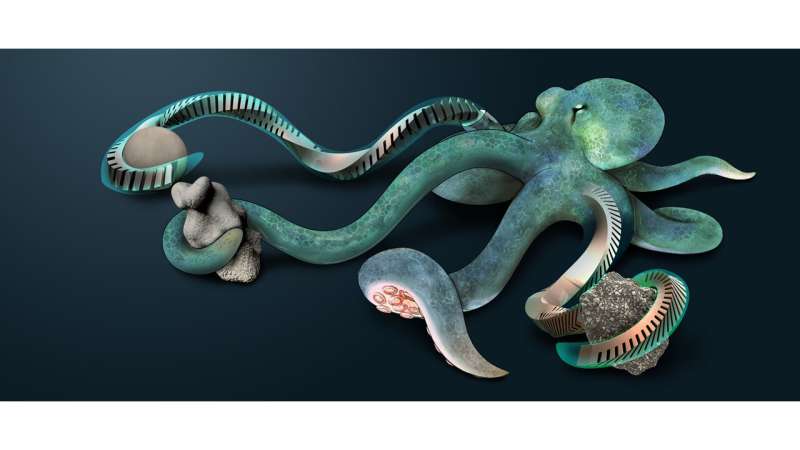Flexible tentaclelike robotic manipulators inspired by nature

Traditional robots can have difficulty grasping and manipulating soft objects if their manipulators are not flexible in the way elephant trunks, octopus tentacles, or human fingers can be.
In Applied Physics Reviews, investigators from Shanghai Jiao Tong University in China developed a type of multiple-segment soft manipulator inspired by these biological systems. The soft manipulators are based on pneu-nets, which are pneumatically actuated elastomeric structures.
These structures have a tentaclelike shape and consist of a series of connected internal chambers which can be inflated pneumatically, blowing them up like a balloon. One side of the tentacle is highly flexible while the other is stiffer. Increasing air pressure to the chambers causes the structure to bend toward the stiff side.
“We have designed soft manipulators using a mathematical model that can follow a particular 3D spatial trajectory,” said author Dong Wang. “Our soft manipulator consists of multiple segments where each segment shows a different actuation mode—twisting, in-plane bending, or helical actuation—by choosing different chamber orientations.
“The key advance of this work is the development of a mathematical methodology that can automatically design soft manipulators matching complex 3D trajectories upon single pressurization.”
The group designed manipulators for a variety of 3D trajectories by varying the geometric, material, and loading parameters for their pneu-net structures. They were able to do an inverse design to create a manipulator that would follow a specific trajectory.
The design method relies on a mathematical model that is much less costly to use than traditional computational models. The group confirmed their mathematical technique produced manipulator designs with behaviors similar to computational models. They validated their results using simple experiments.
“To achieve truly versatile applications of the designed soft manipulators, more work is needed,” said author Guoying Gu.
Among this future work are strategies to extend the approach to systems with multiple actuators. In addition, the inverse design process is still not fully automatic, since the first stage of the process requires a human operator choose the regions of the curve that are assigned to twisting, bending, or helical deformation.
“We can envision an automated system to do this step using machine learning or other methods,” said Gu.
This work should have applications in robotic grippers, implantable and wearable devices, and robots moving through unpredictable terrains.
Technique speeds up thermal actuation for soft robotics
“Modeling and inverse design of bio-inspired multi-segment pneu-net soft manipulators for 3-D trajectory motion” Applied Physics Reviews, DOI: 10.1063/5.0054468
Citation:
Flexible tentaclelike robotic manipulators inspired by nature (2021, December 21)
retrieved 21 December 2021
from https://techxplore.com/news/2021-12-flexible-tentaclelike-robotic-nature.html
This document is subject to copyright. Apart from any fair dealing for the purpose of private study or research, no
part may be reproduced without the written permission. The content is provided for information purposes only.
For all the latest Technology News Click Here
For the latest news and updates, follow us on Google News.
